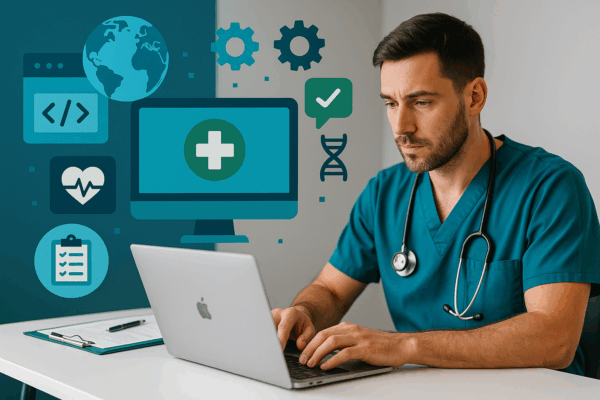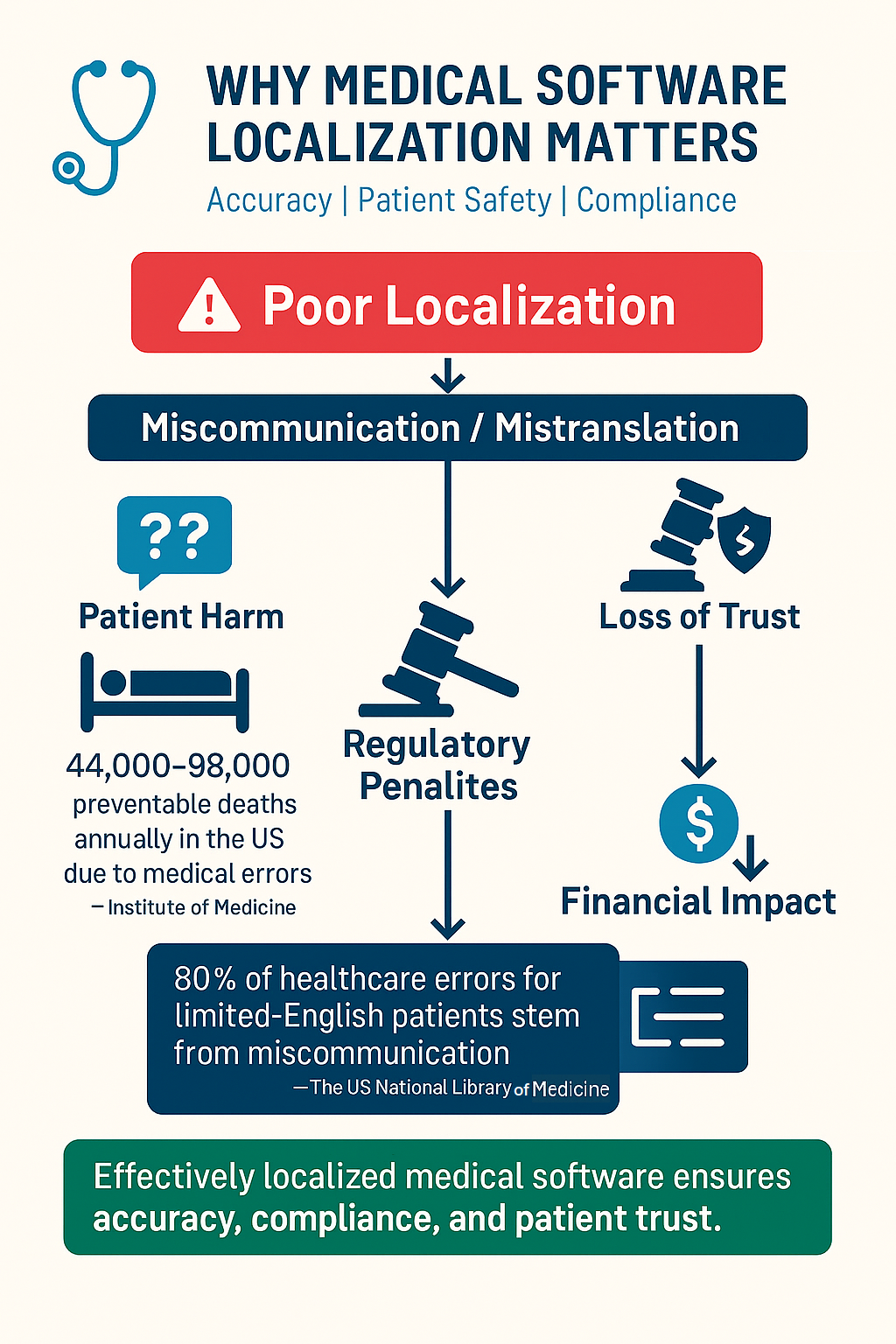Have a Big Project?
Big numbers, lots of documents and multiple translations?
Our top performing teams deliver unmatched quality on time for you
to hit your business goals.

If you’re developing or scaling medical software, there is one thing that matters above all others when it comes to medical software localization. Since medical software localization is about ensuring accuracy, protecting patient safety, and meeting regulatory compliance in various markets, you need to remember that localization is a multi-step process that starts with translation but extends to many other factors.
The stakes couldn’t be higher. A single mistranslation in a diagnostic tool, patient portal, or clinical support app can mean misdiagnoses, treatment errors, or legal consequences. According to the Institute of Medicine’s landmark To Err Is Human report, preventable medical errors cause between 44,000 and 98,000 deaths annually in the U.S. alone. Many of these cases stem from miscommunication, highlighting why localization in healthcare technology cannot be an afterthought.
From telemedicine platforms used by patients to specialized clinical systems designed for healthcare professionals, effectively localized medical software is what enables safe, seamless, and trusted care worldwide. In this guide, we’ll explore what makes medical software localization unique, which elements require the most attention, common challenges to anticipate, and best practices that ensure global readiness.
Table of Contents:
1. Why Medical Software Localization Is Unique
2. Key Elements of Medical Software Translation
3. Best Practices for Medical Localization
4. Your Next Steps to Medical Software Localization

Unlike e-commerce, gaming, or general apps, medical software localization carries zero tolerance for error. Because it directly affects patient safety and clinical decisions, every word, unit, and workflow must be precise, compliant, and culturally adapted.
Medical software must comply with strict regulatory requirements in every target market:
Failing to align with these frameworks can delay product launches, trigger costly rework, or even lead to rejection in new markets. For example, The European Medicines Agency’s 2022 Annual Report highlights that labeling issues, such as missing or incorrect information, continue to play a role in product recalls and compliance actions across the healthcare system. Similarly, Sedgwick’s recall index shows that EU medical device recalls increased overall in 2022, with labeling and documentation problems among the recurring causes.
A mistranslation in medical terminology isn’t just a usability issue — it can cause diagnostic errors, mistreatment, or fatalities. Research shows that 80% of medical errors stem from miscommunication. This makes medical translators and subject-matter experts indispensable in the localization process.
Healthcare is cultural. Symbols, colors, and even icons vary in meaning across regions.
Without cultural adaptation, even perfectly translated software may fail to gain user trust. Unlike most industries, medical localization is not just a matter of communication — it’s a matter of life, safety, and compliance.
When it comes to medical software localization, the margin for error is close to zero. Unlike typical apps, every detail in healthcare technology can directly affect clinical outcomes, compliance, and patient trust. Here’s a deep dive into the elements that demand the most attention:

Medical software contains thousands of strings — instructions, alerts, labels, and diagnostic references — all of which must be localized with precision. Generalist translators aren’t enough. Instead, businesses must rely on medical translators who understand terminology in context, supported by translation memory and standardized glossaries.
✅ Best Practice: Use a terminology management system that is reviewed by medical experts to ensure terms are consistent across updates.
A localized UI is more than swapped-out text. It requires redesigning menus, adapting symbols, and ensuring readability across languages. Text expansion in German can increase character count by up to 35%, while Chinese may contract text by 20%. This impacts button sizes, menus, and instructions.
✅ Best Practice: Design “flexible UI frameworks” early in development to handle multilingual adjustments without breaking the software.
Formatting errors are not cosmetic in medicine — they can be fatal.
✅ Best Practice: Always include unit localization logic in software design and run cross-market testing with clinicians to catch risks early.
Healthcare professionals operate in high-stakes, time-sensitive environments. If a localized workflow feels unnatural, it can delay diagnosis or treatment.
✅ Best Practice: Conduct user testing with healthcare professionals in each target market to validate UX against clinical workflows.
In medical software, compliance text is just as important as the code itself. Every privacy policy, consent form, and disclaimer must meet regulatory requirements in each market.
✅ Best Practice: Involve compliance experts during localization, not after — regulatory debt is expensive to fix.
Localization doesn’t end at the product interface. Patients and healthcare professionals need multilingual support that aligns with the software.
✅ Best Practice: Pair translation services with cultural adaptation to make support resources relatable, not just readable.
Key Takeaway: Truly effective localized medical software isn’t just text-perfect. It’s adapted across content, design, regulation, and support — ensuring patient safety, compliance, and user trust in every market.
To ensure safety, compliance, and scalability, companies should follow these core practices:
These best practices are simple but vital — plan early, adapt culturally, validate with experts, and test rigorously. This balance protects patients and ensures global readiness.
When medical software localization is done right, it safeguards patients, ensures regulatory compliance, and builds credibility with healthcare professionals. Companies that plan localization early, adapt to cultural and linguistic nuances, and adopt continuous workflows are not just avoiding risk — they’re accelerating safer, more effective global rollouts.
The difference lies in expertise. By partnering with specialists in medical software translation and medical localization services, businesses can navigate terminology challenges, meet regulatory requirements, and deliver software that works seamlessly in every target market. If you’re preparing to expand globally, now is the time to make localization a core pillar of your strategy.
Big numbers, lots of documents and multiple translations?
Our top performing teams deliver unmatched quality on time for you
to hit your business goals.
Ready to burst your borders and need work done quickly?
Order Now! To get an instant assessment and quote.
Don’t wait, we’re ready.
SAVE TIME & MONEY!
Order from our mobile app now